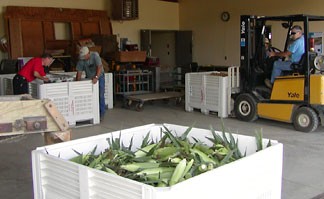CU donates a record 82 tons of produce to area food banks
By Lauren Chambliss
As one of the world's leaders in agricultural research, Cornell's reputation spans the globe. But closer to home in local-area neighborhoods, Cornell's field-research facilities fill an urgent community need – providing needy families with quality produce.
Last year, Cornell's Homer C. Thompson Research Farm in Freeville donated a record 178,000 pounds – or about 82 tons – of fresh produce, more than double what the research farm gave away in 2004, to three local food banks. The bounty included bushels of fresh potatoes, corn, green beans, beets, melons and a large crop of collard greens.
Every August, Freeville Farm's manager Steve McKay calls the food banks about the harvest. The Food Bank of the Southern Tier in Elmira, for example, serves more than 22,000 households a year. Two local, smaller organizations, Ithaca's Friendship Donation Network and Cortland's Loaves and Fishes, also receive donations from the Freeville Farm, which is part of Cornell's Agricultural Experiment Station.
"During the harvest season, Freeville is our second-largest contributor, providing us with the most important products for food nutrition and health to Ithaca families," says Sarah Pines, director of Friendship Donations Network, which provides donated, perishable foods to supply about 2,500 meals to Ithaca's needy per week. "I cannot say enough about the extraordinary effort that Steve and his staff put into making quality produce available to families that often cannot afford vegetables."
Freeville Farm produce, which includes organic and conventional, is grown for research projects in the College of Agriculture and Life Sciences. In many cases, the faculty and students help pick crops and place them in 20-bushel bins that McKay purchased several years ago to facilitate the donation process.
Robin Bellinder, professor of horticulture, began the program in the late 1990s when she realized that the produce generated by her projects would be better off on someone's table than in a compost bin.
"As much as 95 to 98 percent of the vegetables researchers grow are consumable, and the products are mostly produced with public funds," says McKay. "Through the donation program we can contribute back to the community in a direct way and meet a huge local need."
McKay says the growth in donations reflects the expansion of research programs at the site, which is driven by the needs of growers in New York state. Cornell faculty members research growing and production practices and provide that knowledge through the Cornell Cooperative Extension system.
Lauren Chambliss is a communications specialist with the Cornell Agricultural Experiment Station in Ithaca.
Media Contact
Get Cornell news delivered right to your inbox.
Subscribe